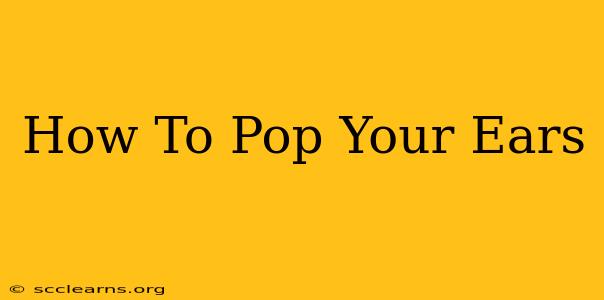Experiencing that uncomfortable pressure in your ears? That's often a sign of blocked Eustachian tubes, the tiny canals connecting your middle ear to the back of your throat. This pressure can be caused by changes in altitude (like on airplanes or in mountains), illness, or even just a change in the weather. This comprehensive guide will explore various safe and effective techniques to relieve that pesky ear pressure and get your ears "popping."
Understanding Ear Pressure
Before diving into solutions, let's briefly understand why ears pop. The air pressure inside your middle ear needs to equalize with the air pressure outside. When this balance is disrupted, you feel that familiar pressure or fullness. This imbalance can lead to discomfort and even pain.
Common Causes of Ear Pressure:
- Changes in Altitude: This is the most common cause, especially during air travel or mountain climbing. As altitude changes, the air pressure changes as well.
- Upper Respiratory Infections (URIs): Colds, the flu, and other infections can cause inflammation and swelling of the Eustachian tubes, obstructing their function.
- Allergies: Similar to URIs, allergies can lead to inflammation and congestion, impacting the Eustachian tubes.
- Barotrauma: This term refers to injuries caused by pressure differences. It can affect various parts of the body, including the ears.
- Diving: Changes in water pressure during diving can also cause ear pressure.
Effective Ways to Pop Your Ears
There are several safe and effective methods to help equalize the pressure in your ears. Here are some popular techniques:
1. The Valsalva Maneuver:
This is the most commonly known technique. It involves gently trying to force air into your Eustachian tubes:
- Pinch your nostrils closed.
- Close your mouth.
- Gently blow air out of your nose as if you're trying to exhale through a blocked nose. Do not blow forcefully; this can be damaging. You should feel a popping sensation as the pressure equalizes.
- Repeat as needed.
Important Note: Avoid this maneuver if you have a respiratory infection or any condition that makes forceful exhaling difficult.
2. The Toynbee Maneuver:
This method uses swallowing to help open the Eustachian tubes:
- Pinch your nostrils closed.
- Close your mouth.
- Try to swallow. You may notice a slight popping sound.
- Repeat as needed.
This maneuver is gentler than the Valsalva maneuver and can be a suitable alternative.
3. Yawning:
A natural way to open your Eustachian tubes is to yawn. Sometimes a simple yawn is all it takes to relieve the pressure.
4. Swallowing:
Swallowing, like yawning, can help stimulate the muscles that control the Eustachian tubes. Chewing gum or sucking on hard candy can encourage more frequent swallowing.
5. Head Movements:
Gentle head movements, such as tilting your head from side to side or forward and backward, can sometimes help to open the Eustachian tubes.
When to Seek Medical Attention
While these techniques are generally safe and effective, it's crucial to seek professional help if you experience:
- Severe ear pain.
- Ear pain accompanied by fever or other symptoms of infection.
- Persistent ear pressure that doesn't respond to home remedies.
- Hearing loss.
- Drainage from the ear.
These symptoms could indicate a more serious issue requiring medical intervention.
Preventing Ear Pressure
Proactive measures can reduce the frequency of ear pressure issues.
- Stay Hydrated: Staying well-hydrated helps maintain the health of your mucous membranes, reducing the risk of congestion.
- Avoid sudden pressure changes: If possible, ascend and descend gradually during air travel or mountain climbing.
- Treat upper respiratory infections promptly: Address any cold or flu symptoms early on to minimize Eustachian tube inflammation.
This guide provides several strategies for relieving ear pressure, but it's not a substitute for professional medical advice. If you have concerns, consult an otolaryngologist (ENT doctor) for personalized guidance. Remember to always prioritize your health and seek professional care when needed.

